Physical Address
304 North Cardinal St.
Dorchester Center, MA 02124
|
|
|
|
|
|
|
|
Cervical spondylosis is a chronic and degenerative consequence of aging that traditionally has been treated with open surgical decompression. Spondylosis can result from degenerative arthritis of the disk space and joints, disk herniation, facet or ligamentous hypertrophy, and spinal instability ( Fig. 45-1 ). Any of these conditions can result in central spinal canal or foraminal stenosis leading to symptoms of cervical myelopathy, radiculopathy, or myeloradiculopathy. Advances in technology have promoted an evolution from open surgery to microsurgical and minimally invasive surgery (MIS) techniques to treat these conditions.
Cervical spondylosis can be treated with an anterior approach, a posterior approach, or combined anterior and posterior surgical approach. Historically, the anterior approach to the cervical spine provides a direct solution to ventral disease. This approach is commonly well tolerated and allows the surgeon to approach the ventral cervical spine with minimal muscle dissection. However, soft tissue exposure in the neck is required. Thus, potential complications include anatomic injury to the adjacent carotid artery or jugular vein, esophagus, trachea, thoracic duct, sympathetic plexus, and superior laryngeal, recurrent laryngeal, or hypoglossal nerves, as well as postoperative dysphagia and accelerated adjacent segment level disease.
Consequently, posterior approaches to the cervical spine remain popular in the treatment of symptomatic cervical spondylosis. Particularly in the treatment of cervical radiculopathy from foraminal stenosis or lateral disk herniation, posterior cervical laminoforaminotomy remains a standard surgical technique that leads to resolution of clinical symptoms in 92% to 97% of patients. For patients with cervical stenosis and myelopathy, cervical laminectomy or laminoplasty results in stable or improved clinical symptoms in 62% to 83% of cases. Unfortunately, the traditional open posterior cervical approach requires significant muscle dissection and retraction, resulting in predictable postoperative pain and prolonged recovery time in 20% to 60% of patients. Therefore, the MIS approach provides an attractive alternative surgical approach to the posterior cervical spine. Specifically in patients with focal disease confined to one to two levels, MIS approaches have excellent outcomes when compared with open cervical procedures.
The fundamental philosophy of MIS in the posterior cervical spine consists of maintaining the normal anatomic structures, preserving the posterior tension band, and minimizing iatrogenic defects. Sequentially muscle-dilating tubes were developed to access the surgical site through a minimal skin and fascia incision, thereby preserving the normal anatomy and structural integrity of the spine. The incorporation of the microscope or endoscope has enhanced the surgical field of view and facilitates excellent surgical outcomes through these minimally invasive access tubes.
The goal of this chapter is to discuss the most recent MIS approaches available for the cervical spine. The main surgical approach described is the minimally invasive posterior paramedian cervical method (transtubular or transmuscular). A microscope, endoscope, or loupes may be used, depending on the surgeon’s preference. This approach is used to perform cervical laminectomy, laminotomy, laminoplasty, foraminotomy, diskectomy, lateral mass screws, tumor resection, or even deformity correction.
Patients with cervical spondylosis usually present with myelopathy, radiculopathy, or myeloradiculopathy. Myelopathic patients typically describe a chronic and progressive stepwise decline in their fine motor function and gait ataxia over a period of months to years. Classic descriptions of fine motor dysfunction include difficulties with buttoning shirts or putting on earrings and trouble with dexterity such as handwriting or typing on a keyboard. Gait ataxia, usually described as a “loss of balance” or “inability to locate the feet” while walking, leads to increased falls. Less common complaints include weakness of hand intrinsic muscles, low back pain, burning paresthesias in the extremities, and bladder or bowel changes. Less than 10% of patients describe having axial or radicular pain as the main symptom.
On physical examination, patients may exhibit signs of extremity weakness, gait imbalance, a positive Romberg sign, hyperreflexia caudal to the site of spinal cord compression, clonus, the Hoffmann sign, or the Babinski sign. Occasionally patients may describe a shooting electrical pain down the spine with neck flexion known as the Lhermitte sign.
In contrast, patients with cervical radiculopathy usually report radiating pain in a dermatomal distribution specific to the compressed nerve root or roots. The pain may radiate from the neck in the midline and extend down to the fingers as burning or electric shooting pain with associated paresthesias. Symptoms are usually acute if they result from trauma, but they may be chronic if they are caused by cervical spondylosis.
On physical examination, patients may have decreased sensation to light touch, pinprick, and vibration in a dermatomal distribution with associated muscular weakness from the compressed nerve root. Patients with chronic compression may have evidence of muscular atrophy or diminished to absent reflexes in the affected nerve root distribution. The radicular pain may be exacerbated and confirmed with the Spurling test (ipsilateral lateral neck flexion and rotation, neck extension with axial loading).
Cervical spondylosis may be seen on radiographs (static or dynamic), but it is more clearly seen on computed tomography (CT) or magnetic resonance imaging (MRI) (or CT myelogram). Evidence of disk degeneration, loss of disk space height, disk herniation, or calcification is usually present. Underlying vertebral body osteophyte formation and hypertrophy of the facets or ligaments also contribute to cervical stenosis. Central canal stenosis may result in myelopathy from spinal cord compression, whereas lateral or foraminal stenosis usually results in radiculopathy from nerve root compression. Additional diagnostic tools include electromyography (EMG) or nerve conduction studies to help localize the level of nerve root compression. For patients with ambiguous myelopathy, EMG and somatosensory-evoked potentials (SSEPs) can help determine whether spinal cord compression with dysfunction is present. Irrespective of the imaging findings, the clinical examination must always match the radiographic findings to ensure an appropriate diagnosis.
Minimally invasive cervical decompression is indicated for patients with myelopathy from cervical stenosis or patients with radiculopathy from nerve root compression. A posterior cervical approach is indicated in cervical nerve root compression from lateral disk herniation, foraminal stenosis, hypertrophy of ligaments or facets, synovial cyst compression, failed indirect anterior cervical decompression, medical contraindication to anterior approach, or patient habitus (short neck). Contraindications to posterior cervical decompression include patients with a straight or kyphotic cervical spine, spinal instability, or inaccessible ventral midline disease.
Before any surgical intervention, extensive discussion with the patient and family should be held to ensure appropriate expectations of surgical outcomes. Patients with radiculopathy should have completed a trial of physical therapy, pain management, steroids, or epidural injections before conceding a failure of medical management. Decompression of the nerve root typically results in immediate relief of pain symptoms, but weakness and paresthesias may take longer to improve, and recovery can be incomplete. Similarly, patients with myelopathy should be counseled that the surgical procedure is intended to prevent further neurologic decline and although some patients may experience some improvement, the operation is not designed to return patients to their previously healthy baseline. Orienting patients to realistic expectations is imperative to a successful surgical outcome. All potential risks of the surgical procedure, including intraoperative complications of surgery or anesthesia and postoperative complications (e.g., urinary tract infections, wound infections, venous thrombosis), should be clearly discussed with the patient preoperatively.
This chapter discusses the available MIS approaches to the cervical spine: microendoscopic decompression for stenosis (MEDS), foraminotomy (MEF), diskectomy (MED), and laminoplasty, as well as MIS approaches for spinal tumors.
The anesthesia and positioning setup is similar for the following posterior MIS cervical approaches unless otherwise stated. General endotracheal anesthesia is performed in a routine manner, except in patients requiring fiberoptic intubation (cervical stenosis with spinal cord compression). Neuromonitoring with motor-evoked potentials (MEPs), SSEPs, and free-run EMG is implemented. An arterial line may be added for patients with spinal cord compression to ensure adequate spinal cord perfusion by maintenance of elevated mean arterial pressure. A Foley urinary catheter is generally not needed in patients with one- or two-level disorders. Sequential compression devices are used in conjunction with knee-high compression stockings to minimize the risk of deep venous thrombus formation. Perioperative antibiotics with skin flora (gram-positive bacteria) coverage are given before incision. Muscle relaxants are usually unnecessary after anesthesia induction because MIS approaches require minimal muscle dissection or retraction.
Positioning of the patient in MIS cervical approaches is influenced by the size and length of the neck, shoulder height, and surgical level. The head is secured with the Mayfield head holder in either the prone or upright sitting position. The senior author prefers the sitting position because it reduces epidural bleeding and fluid accumulation in the operative field, decreased airway or facial edema and anesthesia time, and improved visualization of lateral cervical radiographs secondary to gravity traction on the shoulders.
The surgical site is cleaned with alcohol solution, and the midline is approximated by palpation of the spinous processes between two fingers and outlined by a marking pen. The surgical site is then hand scrubbed in sterile fashion with a povidone-iodine (Betadine) solution, painted with alcohol, and reprepared with DuraPrep. The patient is draped in the usual sterile fashion, and the fluoroscopy machine is brought into the field to localize the level of disease ( Fig. 45-2 ).
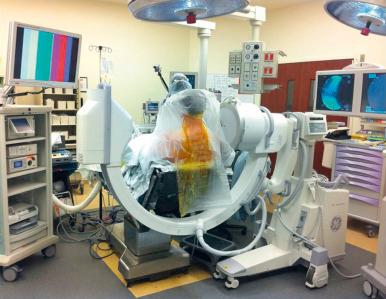
The following steps are similar for microendoscopic foraminotomy, diskectomy, and decompression. Anatomic landmarks helpful in surgical planning include the angle of the mandible (C2 vertebral body), the first bifid spinous process (C2), and the prominent spinous process (C7). An ipsilateral paramedian line is drawn approximately 1.5 cm from the midline. The fluoroscopy machine is positioned for lateral radiographs, and the surgical level is approximated with a small dilator tube placed over the paramedian line ( Fig. 45-3 ). The point of entry is marked before injecting the skin and underlying fascia with local anesthesia. The skin and fascia are incised (2.0 cm) with a scalpel, and Metzenbaum scissors are used to dissect the paraspinal muscles bluntly down to the facet joint. Placement of sequential tube dilators is then performed ( Fig. 45-4 ). The final tubular retractor (∼18 mm) is secured in place with the flexible table-mounted retractor arm, and the final position is confirmed by lateral fluoroscopy ( Fig. 45-5 ). Use of a Kirschner wire (K-wire) before dilator placement is not recommended in the cervical spine. At this point, the microscope, loupe, or endoscope (preference of the senior author) is used to facilitate soft tissue dissection over the lamina-facet junction.
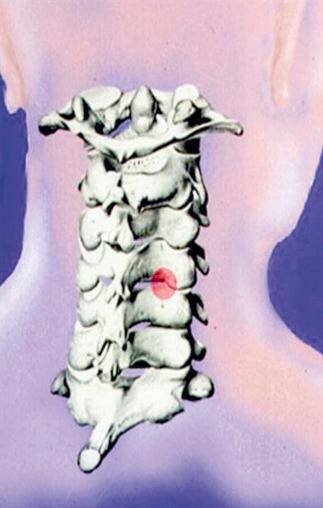
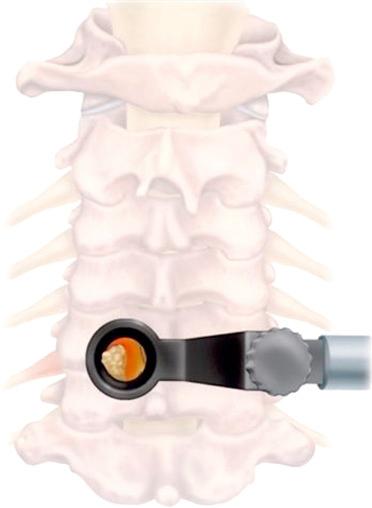
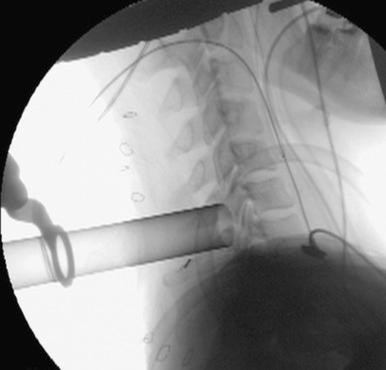
Before using the endoscope, it should be optimally focused, with contrast and brightness adjusted, orientation confirmed with a stationary object (an upright thumb is sufficient), white balanced, and “defogger” applied ( Fig. 45-6 ). The tip of the endoscope should be placed as close as possible to the surgical field (∼1 cm away) to improve visualization. Long-handle monopolar electrocautery and suction are used in all minimally invasive tubular systems. Caution should be used with the endoscope because monopolar electrocautery activity adjacent to the endoscope tip may create an “electrical arc” and burn the endoscope lens.
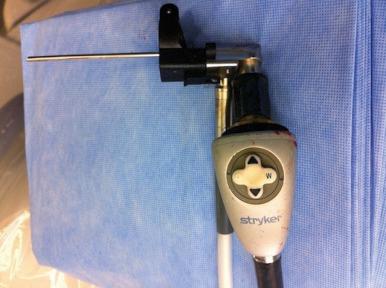
Under improved visual guidance, monopolar electrocautery is used to dissect the soft tissue away from the lamina-facet junction, by working from the rim of the dilation tube toward the center in a 360-degree fashion and staying on bone at all times to prevent inadvertent “plunging” into the spinal canal. A pituitary rongeur is used to remove cauterized soft tissue, and an up-angle curet is used to create a plane between the lamina or facet and the underlying ligamentum flavum. A hemilaminotomy is begun using 1- and 2-mm Kerrison rongeurs. This initial exposure is similar for MED, MEF, and microendoscopic diskectomy.
After the initial exposure, foraminal stenosis can be treated by MEF. The medial one third to one half of the facet is dissected free, and a pneumatic drill is used to thin out the inferior facet of the rostral vertebral body and the superior facet of the caudal vertebral body. A laminotomy “keyhole” is completed in conjunction with the medial facetectomy and exposure of the underlying ligamentum flavum ( Fig. 45-7 ). The residual bony fragments are removed with a Kerrison rongeur. The up-angle curet is placed in the cephalad and caudad portions of the foramen and is confirmed with lateral fluoroscopy to ensure that adequate bony decompression of the foramen is complete. The up-angle curet is then used to create a plane between the ligamentum flavum and the underlying thecal sac. A Kerrison rongeur is used to resect the ligament and any residual bone overlying the disk space until the dura and exiting nerve root (both cephalad and caudal surfaces) are visualized. A nerve hook is used to confirm appropriate foraminal decompression before obtaining hemostasis and irrigating the field with antibiotic solution.
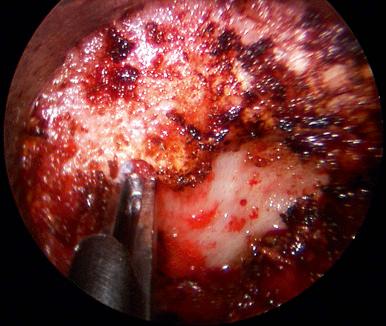
Removal of one third to one half of the medial facet at a single level is rarely associated with future spinal instability. If a lateral disk herniation is present, it will be located ventral to the exiting nerve root. To improve access to the disk space, drilling 2 to 3 mm of the superomedial portion of the caudal pedicle improves visualization and mobility for decompression. A small micropituitary rongeur is used to extract the herniated disk fragment, with care taken to avoid traction injury to the nerve root or the thecal sac. A micronerve hook is placed inferior and ventral to the nerve root to gently free away any residual disk fragments for removal. Any disk fragments should be removed if easily accessible but “should not be chased” behind the thecal sac.
Become a Clinical Tree membership for Full access and enjoy Unlimited articles
If you are a member. Log in here